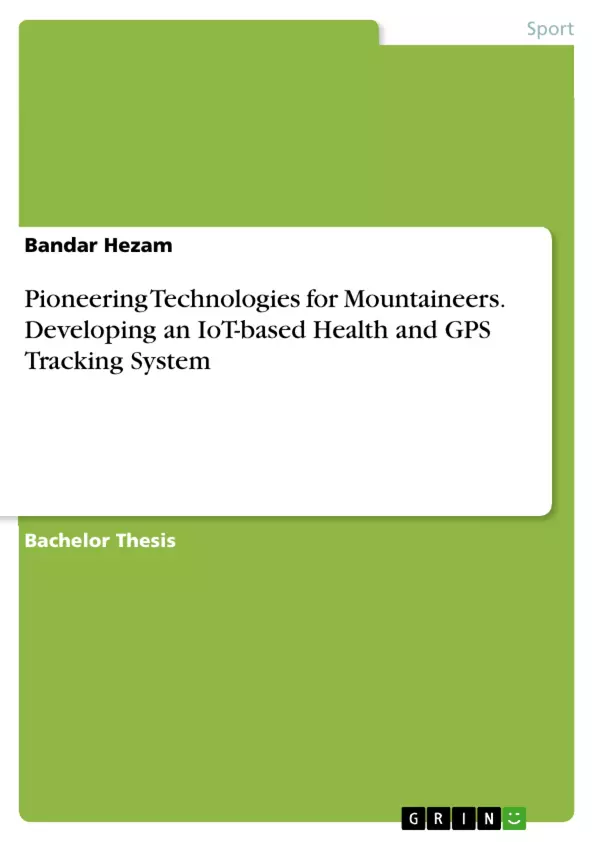In the contemporary realm of adventure sports, the safety of mountaineers takes center stage. This study aims to forge an IoT-based solution capable of real-time monitoring of not only the location but the health of mountaineers, thereby minimizing potential risks and facilitating rapid response in emergencies. The summary offers a detailed overview of the various chapters and sections integral to this pivotal research.
The introduction highlights the prominence of mountaineering as a global sport and delineates the challenges and risks associated with it. It emphasizes the imperative for a reliable health monitoring system that withstands physical constraints while being lightweight and wearable.
Chapter one delves deeply into the problem statement and the study's objective, focusing particularly on creating a wearable device that monitors the health and location of mountaineers in real time.
Chapter two furnishes a comprehensive review of the existing literature, particularly focusing on the diverse technologies and systems presently utilized for health monitoring and navigation.
In chapter three, the concept development and research methodology are detailed extensively. Here, the various phases of the project, including material and software selection, as well as the proposed methodology, are discussed.
The document concludes with an extensive repository of references and an appendix that includes a literature review matrix.
Inhaltsverzeichnis (Table of Contents)
- CHAPTER 1: INTRODUCTION.
- 1.1 Introduction
- 1.2 Problem Statement
- 1.2 Aim and Objective of the Study
- 1.2.1 Aim of the study
- 1.2.2 Objectives of the study
- 1.3 Scope and Limitations
- 1.3.1 Scope
- 1.3.2 Limitations
- 1.4 Justification for the research
- 1.5 Remaining Chapters Outline
- 1.6 Summary
- CHAPTER 2: LITERATURE REVIEW.
- 2.0 Introduction
- 2.1 Literature review
- 2.1.1 Review of GPS Tracking Systems
- 2.1.2 Review of Sensor Technologies for Health Monitoring
- 2.1.3 Review of Mobile and Web-Based Interfaces for Health Monitoring
- 2.1.4 The drawbacks and disadvantages of the existing methods
- 2.2 Similar systems
- 2.2.1 Title: IOT Based Soldier Navigation and Health Monitoring System
- 2.2.2 Title: Healthcare monitoring of mountaineers by low power Wireless Sensor
- 2.2.3 Title: Wearable Sensors in Intelligent Clothing for Human Activity Monitoring
- 2.2 Summary
- CHAPTER 3
- CONCEPT DESIGN AND RESEARCH METHODOLOGY
- 3.1 Introduction
- 3.2 Investigation on materials and components selections
- 3.2.1 Pre-processing
- 3.2.2 Software selection
- 3.3 Proposed methodology
- 3.4 Concept design based on fundamental engineering principles
- 3.4.1 Introduction
- 3.4.2 Sensor Inputs
- 3.4.3 Arduino
- 3.4.4 Wi-Fi Module
- 3.4.5 Web Application
- 3.4.6 Programming
- 3.5 Proposed System's Initial Approach
- 3.6 Proposed
- 3.7 Professional Engineering Practices
- 3.8 Project management, Finance and Entrepreneurship
- 3.9 Summary
- Importance of health monitoring in mountaineering
- Application of IoT and GPS technology for real-time health tracking
- Design considerations for wearable devices in challenging environments
- Data collection, transmission, and analysis for health monitoring
- Improvement of safety and emergency response in mountaineering
Zielsetzung und Themenschwerpunkte (Objectives and Key Themes)
The aim of this study is to develop a wearable device that utilizes the Internet of Things (IoT) and GPS technology to monitor the vital signs and locations of mountain climbers in real-time. This project investigates the importance of monitoring the health of mountain climbers in challenging environments and the potential benefits of using IoT and GPS technology in developing such a system. The system aims to be technically advanced, lightweight, and durable, effectively addressing the challenges of monitoring climbers in remote and high-altitude locations. The study addresses the lack of real-time monitoring of climbers' health, highlighting the risks and potential consequences of delayed medical assistance. The system aims to improve the safety and well-being of mountain climbers by providing real-time data and enabling prompt response in emergency situations.
Zusammenfassung der Kapitel (Chapter Summaries)
Chapter 1 introduces the concept of mountain climbing as an adventurous sport with inherent risks to climbers' health and safety. It outlines the problem statement, highlighting the difficulties in monitoring climbers' health and location in remote and high-altitude locations. The chapter establishes the study's aim and objectives, focusing on the development of an IoT-based wearable device for real-time health monitoring and GPS tracking. Chapter 2 delves into the existing literature on GPS tracking systems, sensor technologies for health monitoring, and mobile and web-based interfaces for health monitoring. The chapter also analyzes the drawbacks and disadvantages of existing methods and explores similar systems that have been developed for health monitoring in various contexts. Chapter 3 focuses on the concept design and research methodology for the proposed system. It outlines the selection of materials and components, including pre-processing techniques and software selection. The chapter details the proposed methodology, encompassing the concept design based on engineering principles, sensor inputs, the use of Arduino and Wi-Fi modules, and web application development.
Schlüsselwörter (Keywords)
The study focuses on the intersection of health monitoring, IoT technology, GPS tracking, and mountaineering. The main keywords include wearable devices, sensor technology, real-time data, remote monitoring, GPS navigation, health data analysis, and emergency response. This research aims to contribute to the development of a comprehensive and reliable system for enhancing the safety and well-being of mountain climbers through the integration of cutting-edge technology.
- Arbeit zitieren
- Bandar Hezam (Autor:in), 2023, Pioneering Technologies for Mountaineers. Developing an IoT-based Health and GPS Tracking System, München, GRIN Verlag, https://www.grin.com/document/1393004



